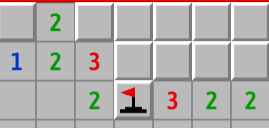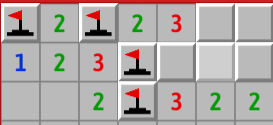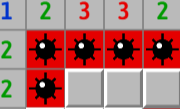Fastest Minesweeper Time: Tips to Excel & Win

When playing Minesweeper as a beginner, you are unlikely to worry about your speed of play. Once you start to defeat the grid more frequently than it beats you, though, time becomes one of the most important metrics for measuring your improvement as a player.
This quick guide will reveal everything you need to know from the average Minesweeper times to the strategies needed to improve your game. Let’s get started.
What Is A Good Time For Completing Minesweeper?
Minesweeper is challenging enough without even when not worrying about speed. So, when thinking about becoming a faster player, a quick look at the World Records can be quite daunting. The record for the expert setting is under 30 seconds while the beginner level has been completed in 0.09 seconds.
However, you don’t have to be a Minesweeper speedrun expert to be considered a fast player capable of completing games quicker than most. Ultimately, only competitive players should be looking to beat the game in seconds. As a casual player, the following timeframes could serve as a good indicator;
- Beginner (9x9 grid, 10 mines) - up to 3 minutes.
- Medium (16x16 grid, 40 mines) - up to 8 minutes.
- Hard (24x16 grid, 70 mines) - up to 15 minutes.
- Expert (30x16 grid, 99 mines) - up to 20 minutes.
Ultimately, though, the most important thing is to beat the game rather than lose due to rash decisions. Even when you do look to improve your Minesweeper times, try to focus on beating your previous times rather than comparing yourself to others. Aside from removing the threat of stealing joy by making your progress feel less significant, it should facilitate quicker development.
Mastering The Grid Layout & Fundamentals For Faster Play
Whether your goal is to become a quicker Minesweeper player or simply win more games, you need to master the fundamentals of the game. Whether playing standard Minesweeper or a themed version like Easter Minesweeper, the grid sizes and number of mines will be as described above.
When looking at the grid, you should remember that middle cells are surrounded by eight adjacent squares. Conversely, corners only have three while even edges (not corners) only have five adjacent squares to consider. So, when a number is revealed in those spaces you should be able to determine where the mines are with greater ease. As such, starting with a corner or edge of the grid can be a great starting point that uncovers a lot of cells with just a few clicks.
Working with the edges rather than the middle also means there are fewer mines to potentially click while you only have to worry about working in one direction rather than spreading out in both. Again, it can be particularly useful when beginning to develop faster play.
While identifying where the mines are is the end goal, you should not ignore the benefits of knowing where they are not. For example, if you have already spotted a mine and an adjacent cell contains a ‘1’. You know that all remaining cells that touch the ‘1’ are free. Clicking those could start a chain reaction, especially when you reach a cell that is not touching a mine as this automatically opens its own adjacent cells.
Perhaps most obviously, though, practice makes perfect. Even if you are capable of clearing expert levels, you should start with the easy setting to develop faster play. It’ll expose you to the patterns that you will then come across in sections of larger boards.
Essential Minesweeper Strategies
Despite its long-term existence, new Minesweeper techniques are regularly developed. So, it certainly pays to be present in the Minesweeper community. When developing a strong foundation for improved play, though, the following strategies are key:
Memories 1-2-1 and 1-2-2-1
When you encounter a situation where three cells are in a 1-2-1 formation with no row (or an empty row) beneath, the solution is to place a flag above each of the 1s. This is the only way in which the 2 can hit two mines without compromising the rule set by the 1s.

Conversely, if it is a 1-2-2-1 pattern, the mines are directly above the two 2s. Understanding patterns like this will help you work your way through sections of the grid without thinking.
Pattern Reduction
Of course, to get the fastest times you need to confirm where the mines are ASAP. However, pattern reduction can be a very valuable tactic. In this example, the two 3s are touching a flag, so you know that each one is adjacent to two more mines.
When combined with the other clues, such as the 2 on the top line, we can quickly work through the pattern.


Quick Guessing
Sometimes the board will develop in a way where a guess is needed based on the localized clues currently available. Sometimes you will have a situation where there are two boxes available and the knowledge that one contains a mine while the other is free.
If no further clues can be developed in the surrounding area, there will be a time when you have to make a guess. Frankly, you might as well do this ASAP. If you get it wrong, you’ve ended the game now rather than later on, which allows you to move onto the next. And if you get it right, you’ll have saved yourself from the mental distraction of knowing that a guess will need to be made later on.
Identifying Clusters
On the one hand a cluster of mines could increase your chances of hitting one if you’re not careful with your early moves. On the other hand, though, pinpointing three, four, or five mines in a few seconds can help you move through the game far quicker.
In this example a bomb was hit elsewhere. However, the combination of numbers starting from the 1 confirm where five mines are placed. Even on a medium sized grid, that’s 1/8th of the danger squares identified within seconds.

Learning From Minesweeper Mistakes
Every game of Minesweeper is winnable. Moreover, over 99% of boards that use standard rules regarding size and the volume of mines are solvable. So, unlike lost games in Solitaire, you can be almost certain that a mistake was made en route to hitting a mine.
Addressing those mistakes won’t only help you improve your win ratios. It also allows you to quicken your speed of play as you’ll be able to recognize the errors and resist them with greater confidence. In turn, future games will see you make the right calls with split second efficiency, thus helping you navigate your way through the game at lightning speeds.
Some of the most common mistakes that either cost time or cause defeat include;
- Misclicking by trying too hard to complete the game quickly or using the wrong button.
- Missing patterns like the 1-2-1 pattern.
- Ignoring something you’ve spotted to solve an ‘easy’ section before having to solve the original matter again.
- Guessing when it would’ve been possible to gain certainty after a few more clicks.
- Misreading how the clues from two adjacent cells explain the surrounding area.
For the sake of a few seconds, it is always worth reviewing the board at the end of the play. The ability to understand how you could have identified the mine you clicked can help you learn from experience.
Advanced Time-Saving Techniques
Quick play is heavily dependent on developing strategies and sharpening your ability to ‘read the grid’ with patterns and critical thinking. Nevertheless, Minesweeper is a game with a history deeply rooted in helping computer users learn the fundamentals of clicking. Unsurprisingly, then, the mechanical aspects of navigating the screen and confirming your moves can shave seconds off of your time.
General alertness and hand-eye coordination will help, but the best time-saving techniques involve smarter moves with the mouse and calculated decisions on what to click. Here’s how to speed up your game without even changing your logical thinking;
- Rather than clicking the flag icon to turn the board green and enter flag mode, place a flag on a mine by right clicking on the cell. This turns a three step move into a single click, thus saving time.
- When you have a mine in a spot where all adjacent squares have been opened, avoid flagging it as you’re not going to click it and placing a flag has no impact on your next moves.
- Hit the pause button if you need to take a quick break for the toilet, to sneeze, or exercise your eyes. Some would call this cheating, but you can’t see the grid in pause mode.
Depending on which platform you play on, it may be possible to do a 1.5 click to reveal mines and free squares adjacent to a cell that has already been revealed. The process of doing this will vary from one platform to another.
Crucially, you can also save time on Minesweeper by selecting the right website. A game disrupted by lagging or unnecessary graphics to reveal cells will hold you back. A simple yet sophisticated solution like 247 Minesweeper is the answer. Whether playing for speed or fun, try it out today.
Seasonal Minesweeper Games
More Games
Minesweeper News
Disclaimer
DISCLAIMER: The games on this website are using PLAY (fake) money. No payouts will be awarded, there are no "winnings", as all games represented by 247 Games LLC are free to play. Play strictly for fun.

































